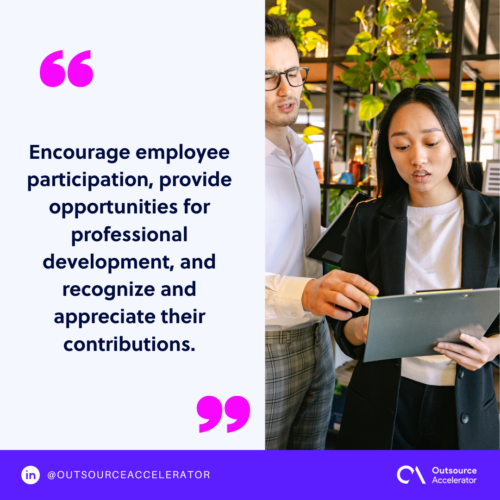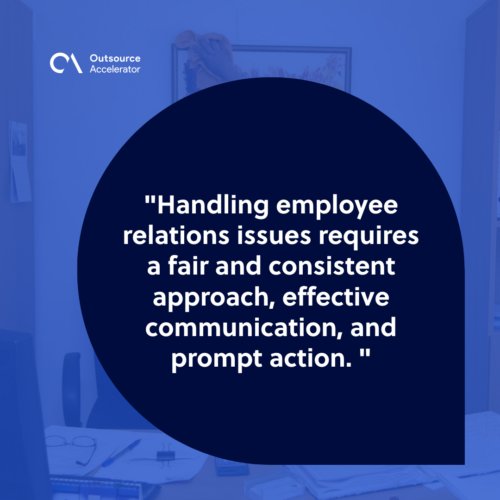Employee relations: Why every business needs it to succeed

The significance of employee relations has never been more pronounced than in the modern workplace. Organizations across industries increasingly recognize the importance of fostering healthy and collaborative relationships with their employees.
At its core, employee relations foster a harmonious coexistence between employers and their workforce. Investing in this discipline is a strategic endeavor when navigating the intricate terrain of workplace dynamics.
Join us as this article examines the importance of cultivating strong employee relations and explores actionable approaches to drive positive outcomes in your workplace.
What is employee relations?
Employee relations refers to the interactions, connections, and overall relationships between employees and their employers. It covers different activities and practices to manage and cultivate a positive and productive work environment.
Effective employee relations involve promoting trust, fairness, and open dialogue. It also ensures compliance with relevant employment laws and regulations.
Employee relations aim to build a mutually beneficial partnership between employees and the organization, ultimately contributing to the business’s success and sustainability.

The role of employee relations manager
An employee relations manager handles the relationship between an organization and its employees. This role is typically within the human resources (HR) department and focuses on creating and maintaining positive relationships.
It involves various responsibilities to maintain a constructive work environment, promoting employee well-being, and ensuring adherence to company policies and procedures.
Some common responsibilities of an employee relations manager include the following:
- Developing employee assistance programs (EAPs)
- Handling complaints and issues
- Advising on employee policies
- Providing guidance on employee discipline and termination
- Employee engagement
Why employee relations is important
Employee relations is important for several reasons, as it significantly impacts an organization’s success, productivity, and overall work environment.
Here are some reasons why employee relations are crucial:
Positive work environment
The retention and attraction of great talent depends on a positive workplace culture. Employee relations contribute to developing a culture of respect, fairness, and inclusivity.
This also leads to higher job satisfaction, increased productivity, and improved employee morale.
Productivity and performance
Strong employee relations can lead to better performance and efficiency. When employees feel valued and supported, they are more likely to be engaged and committed to their work, leading to higher performance and output levels.
Employee retention
Positive employee relations help in attracting and retaining talented employees. A healthy relationship with your job results in satisfaction and loyalty, meaning people are less likely to seek employment elsewhere.
This also helps reduce the associated costs of recruitment and training.
Compliance with laws and regulations
Employee relations practices ensure that the organization complies with labor laws and regulations. Failure to do so can result in legal issues, fines, and damages to the organization’s reputation.
Reputation and brand image
A positive reputation for employee relations can be a competitive advantage. Organizations that treat their employees well are more likely to attract customers, clients, and partners.
It’s beneficial to want to be associated with socially responsible and ethical organizations.
Examples of employee relations responsibilities
The responsibilities of those handling employee relations encompass a wide range of tasks and activities. These are all aimed at fostering a positive and productive work environment.
Here are some examples of the many employee relations responsibilities:
Policy development
Employee relations specialists are responsible for communicating and clarifying company policies and procedures to employees. They play a key role in providing guidance on employee handbooks, codes of conduct, and other policies to ensure compliance.
Communication enhancement
In organizations with unions, employee relations professionals engage in collective bargaining negotiations. They facilitate effective communication by serving as liaisons between management and union representatives.
Manage recognition and rewards programs
Employee relations specialists may design and implement reward and recognition programs to motivate and engage employees.
These programs can include incentives, employee appreciation events, or performance recognition to foster a positive work culture.
Improve working conditions
Employee relations professionals may work to enhance the working conditions within the organization. This could involve ensuring a safe and healthy work environment, addressing workplace ergonomics, and promoting wellness initiatives.
They frequently collaborate with safety officers and management to implement employee well-being programs.
Handle wage concerns
Addressing wage concerns falls under the responsibilities of employee relations professionals. They may handle issues related to:
- Pay compression
- Wage discrepancies
- Pay inequities
In doing so, they ensure that employees are compensated fairly and in accordance with legal requirements.
Develop compensation and benefits guidelines
Employee relations specialists contribute to the development and administration of compensation and benefits policies.
They work with HR teams and management to establish fair and competitive salary structures, performance-based initiatives, and employee benefits packages.
Tips to successfully implement employee relations
Successfully implementing employee relations practices requires a thoughtful and strategic approach.
Here are some ways to help you effectively implement employee relations in your organization:
Clear communication and transparency
Create clear and transparent communication channels between management and staff.
Regularly disseminate organizational goals, policies, and changes. Actively listen to employee feedback and address their concerns promptly and effectively.
You should also be transparent in decision-making processes, especially when changes are implemented that may affect employees. Explain the rationale behind decisions to build trust.
Employee engagement
Implement strategies to actively engage employees in decision-making processes and involve them in problem-solving activities. Encourage employee participation, provide opportunities for professional development, and recognize and appreciate their contributions.

Consistency and fairness
Ensure fairness and consistency in HR practices and employee treatment. Remember to treat all employees with respect and dignity, providing equal opportunities for growth and development.
This also extends to applying policies and procedures consistently and fairly across all employees. Watch out for any biases and discriminatory behaviors, as these hinder trust and credibility.
Feedback mechanisms
Create mechanisms for employees to provide feedback. You may provide platforms like the following:
- Suggestion boxes
- Anonymous surveys
- Regular meetings
Use this feedback to make necessary changes and address employee concerns. Don’t forget to communicate any changes resulting from employee input.
Training and development
Invest in training and development programs to enhance skills and capabilities. These should be accessible for both employees and managers.
Training can cover conflict resolution, diversity and inclusion, leadership skills, and effective communication in the workplace. These kinds of programs not only contribute to a harmonious work environment but also promote professional growth and career advancement.
Promote work-life balance
Encourage work-life balance by implementing policies and programs that support employee well-being.
You can offer flexible work arrangements, promote mental and physical health initiatives, and encourage the utilization of time off to prevent burnout.
Recognition and rewards
Recognize and reward employees for their contributions and achievements. You can institute a system that publicly rewards them for their hard work, dedication, and outstanding performance.
Acknowledgment can boost morale and foster a sense of appreciation.
Continuous improvement
Keep in mind that employee relations is an ongoing process. Evaluate and review your initiatives regularly to see if they’re working.
You can monitor factors like employee satisfaction, engagement, and retention rates. Make necessary improvements based on feedback and your employees’ evolving needs.
Employee relations issues and how to handle them
Employee relations issues can arise in any workplace. Handling them effectively is crucial to maintain morale, productivity, and overall success.
We’ve outlined some common employee relations issues and strategies for handling them:
Conflict among employees
Issue: Workplace conflicts between employees, teams, or managers can disrupt productivity and create tension.
Handling: Encourage open communication between the involved parties to discuss the issue fully and honestly. If necessary, you can bring in a neutral third party to mediate. Ensure that expectations and boundaries are set to prevent future conflicts.
Performance issues
Issue: Employee performance that falls below expectations can affect team morale and productivity.
Handling: Identify the root causes of the performance issues by conducting performance evaluations and providing constructive feedback. Collaboratively create action plans with the employee to address their performance gaps. If necessary, offer additional training or resources.
Employee workplace grievances
Issue: Employees may have complaints or concerns about their working conditions, treatment, or policies. Unsafe work environments can jeopardize well-being and organizational compliance.
Handling: First, establish a clear procedure for people to express their grievances and ensure confidentiality. Then, respond to these issues promptly and conduct impartial investigations. Take necessary actions to address the concerns. If they’re safety issues, prioritize these first.
Discrimination and harassment
Issue: Harassment or discrimination based on gender, race, age, or disability can create a hostile work environment. The International Labor Organization’s 2022 survey notes this has affected up to 23% of all workers worldwide.
Handling: Take any form of discrimination or harassment seriously. Conduct a thorough investigation and implement robust policies to prevent such behaviors. Provide training to raise awareness as well as how to report any incidents. Take disciplinary actions if necessary.
Employee misconduct
Issue: Employee misconduct can cover frequent absences, chronic lateness, bullying, or other violations of company policies or codes of conduct.
Handling: Conduct a fair and intensive investigation to gather evidence and determine the appropriate action to be taken. Follow the organization’s disciplinary procedures, which may involve issuing warnings, implementing corrective actions, or termination, depending on severity.
Communication breakdown
Issue: Communication breakdowns can result in misunderstandings and conflicts.
Handling: Encourage open dialogue across all levels of the organization. Regularly share updates, objectives, and changes with employees. Foster a culture of transparency and provide opportunities for feedback.
Lack of employee engagement
Issue: Low employee engagement can lead to decreased productivity and job satisfaction.
Handling: Conduct surveys or one-on-one discussions to identify the root causes of disengagement. Implement strategies to boost employee engagement, such as regular team meetings, recognition programs, and development opportunities.
Handling employee relations issues requires a fair and consistent approach, effective communication, and prompt action.
Additionally, seeking guidance from Human Resources professionals or legal experts can be beneficial in complex situations.

Make the workplace a better and safer place
Creating a better and safer workplace through successful employee relations is not just a transactional endeavor but a transformative one.
As we conclude this article, one thought shines brightly: a workplace rooted in open communication, trust, fairness, and respect is not just a desirable goal but an attainable reality.







 Independent
Independent




